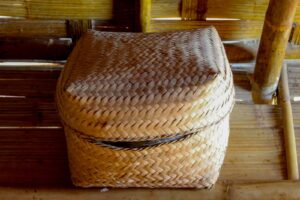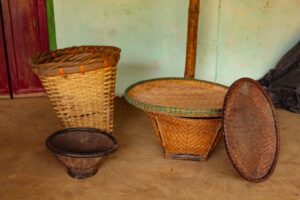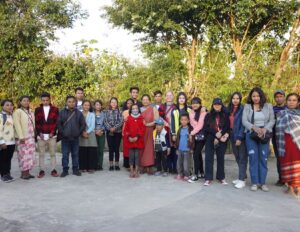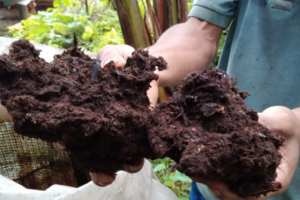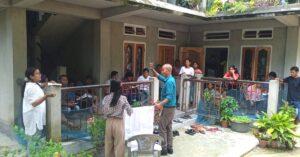“How Indigenous Communities Sustain Tradition and Livelihood Through Bamboo Crafting”
Bamboo craft, an ancient tradition steeped in history, has endured the test of time, serving as a vital livelihood for rural communities. Utilizing bamboo as its primary material, this age-old practice fosters the creation of exquisite crafts and artefacts and provides a significant source of employment and income for rural populations. The versatility of bamboo is truly remarkable, with every part of the plant offering a marketable purpose: from the delectable young shoots used in culinary delights to the sturdy stems employed in crafting furniture and structures, and even the leaves serving as fodder for animals.
Indeed, bamboo’s adaptability knows no bounds, playing a pivotal role in preserving cultural customs and ensuring communities’ subsistence. As we celebrate this timeless tradition, let us rec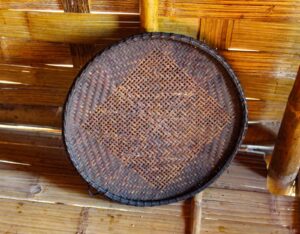 ognise the profound impact of bamboo craft on rural economies and cultural heritage, honouring the artisans who continue to uphold this cherished craft through the generations.
ognise the profound impact of bamboo craft on rural economies and cultural heritage, honouring the artisans who continue to uphold this cherished craft through the generations.
Jatah Lakadong Community
Nestled within the verdant forests of Jatah Lakadong in the East Khasi Hills, the art of bamboo crafting thrives as a cherished tradition among indigenous tribal communities. For generations, the lush landscapes of this region have provided a bounty of bamboo species, each essential for meeting diverse needs within the community. Craft production, deeply ingrained in the community’s cultural fabric, has been passed down through familial lineages, ensuring the preservation of this time-honoured practice.
In Jatah Lakadong, bamboo isn’t merely a resource; it’s a way of life. While some families cultivate bamboo on their properties, the forest remains the primary source of this invaluable material. Nearly every household boasts individuals skilled in crafting, adept at fashioning bamboo into various items tailored to personal needs. Though crafting initially serves as a means of fulfilling domestic requirements, a select few, like Bah Rosit Lating, have turned their passion into a source of financial sustenance.
Bah Rosit Lating, a resident of Jatah Lakadong, embodies the spirit of craftsmanship that permeates the community. Having honed his skills over five years, he initially began crafting for his family’s use, drawing inspiration from observing fellow artisans. As his proficiency grew, so did the demand for his creations among neighbours and community members. His speciality, the “khoh” or conical basket, quickly gained popularity, becoming a sought-after item within the community. Priced affordably between ₹100 to ₹200 per piece, Bah Rosit’s craft meets local demands and fosters a sense of communal support and appreciation.
The bamboo species used for crafting in Jatah Lakadong reflect the region’s rich biodiversity. Bambusa species (Siej shken) and Dendrocalamus species (Siej ktang) are among the most commonly employed varieties. These bamboo species serve as the raw material for crafting a myriad of products, including the iconic conical baskets (khoh), fish traps (ruh pyndap dohthli), storing baskets (ruh doi), and versatile carrying baskets (ruh kiang) used for transporting essentials like tiffin, bill hooks, and plastic items.
The intricate process of crafting begins with the meticulous preparation of bamboo stalks, wherein leaves are carefully removed, and stalks are chopped into appropriate-sized pieces. Subsequently, the stalks are split into thin, flexible bamboo sticks known as “thri,” facilitating the weaving process. These sticks undergo a week-long drying process either under the sun or within chimneys to eliminate moisture content, ensuring the durability of the finished products. Finally, skilled artisans like Bah Rosit weave these flexible sticks into intricate designs, creating functional yet aesthetically pleasing items that are emblematic of Jatah Lakadong’s artisanal heritage.
The art of bamboo crafting in Jatah Lakadong stands as a testament to the resilience, creativity, and community spirit of indigenous tribal communities. As artisans like Bah Rosit continue to weave their craft into the fabric of daily life, they not only preserve cultural traditions, but also foster economic empowerment and solidarity within their community. With bamboo as their medium and tradition as their guide, these artisans exemplify the timeless allure and enduring legacy of this ancient craft.
Khapmaw Community
Nestled in the serene landscapes of East Khasi Hills, lies Khapmaw, a community where tradition intertwines with sustainability. Here, bamboo isn’t just a plant; it’s a way of life. The art of bamboo crafts thrives as a vital part of the indigenous community’s heritage and livelihood.
For generations, the skilled hands of Khapmaw residents have fashioned bamboo into an array of practical items. From baskets to household essentials, these craftsmen harness the versatility of bamboo, turning it into art. While 80% of the men are adept at crafting bamboo baskets for daily use, few venture into selling their creations, relying instead on the forest’s bounty for materials.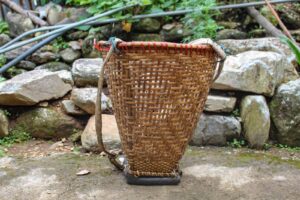
This eco-conscious approach not only showcases bamboo’s myriad uses but also preserves cultural traditions and bolsters the local economy. With each meticulously crafted piece, Khapmaw community members sustain both their heritage and the environment, illustrating the profound connection between tradition and sustainability.
In the verdant hills of this community, the art of bamboo crafting flourishes, woven into the fabric of daily life and heritage. Here, amid the rustling bamboo groves, artisans like Bah Kjik Umsong, Bah Sdiem Umsong, and Bah Disten Suting breathe life into this ancient tradition, infusing it with decades of skill and passion.
At 60 years old, Bah Kjik Umsong stands as a stalwart guardian of Khapmaw’s bamboo craft heritage. With over thirty years of experience, he honed his skills through sheer determination and perseverance. Starting as a young apprentice, Bah Kjik learned the art of bamboo crafting on his own, turning it into a reliable source of supplementary income to support his family. Despite his mastery, Bah Kjik’s main occupations still lie in everyday labor and agriculture, a testament to the resilience and adaptability of Khapmaw’s artisans.
Similarly, Bah Sdiem Umsong’s journey into bamboo crafting began at the age of 27, under the guidance of his fellow community members. Through years of dedication and hard work, he transformed from a novice into a skilled artisan, crafting a variety of products to supplement his livelihood. Gathering bamboo from the forest, Bah Sdiem weaves tradition and innovation into each creation, preserving Khapmaw’s cultural legacy while embracing the demands of modern life.
The process of bamboo crafting in Khapmaw is as intricate as the patterns woven into each product. It begins with the careful selection of bamboo stalks, stripped of their leaves and severed into precise lengths. These stalks are then split or sharpened into various sizes using a sharp knife, a skill passed down through generations.
Depending on the desired outcome, the bamboo strips may require soaking in water for a few days to enhance flexibility. Once crafted into items ranging from baskets to household essentials, these products are either sold directly in the bustling markets of Iew Rynghep/Iew Mawlyngngot or dried in chimneys for a week to remove moisture, ensuring durability and longevity.
Beyond the practicality of bamboo craft, lies a deeper ethos of sustainability and community empowerment. For the artisans of Khapmaw, bamboo isn’t just a material; it’s a lifeline connecting them to their roots and providing a means of economic independence. Through their labour, they uphold centuries-old traditions, weaving stories of resilience and ingenuity into each meticulously crafted piece.
In the hills of Khapmaw, bamboo isn’t just a plant—it’s a symbol of resilience, creativity, and community. Through the skilled hands of artisans like Bah Kjik Umsong, Bah Sdiem Umsong, and Bah Disten Suting, this ancient craft continues to thrive, bridging the gap between tradition and modernity. As they gather bamboo from the forest and transform it into works of art, they breathe life into their heritage, ensuring that the legacy of Khapmaw’s bamboo craft endures for generations to come.
Khliemumstem Community
Nestled in the scenic landscapes of Ri Bhoi, the community of Khliemumstem pulsates with the rhythm of tradition, where bamboo craft thrives as a vibrant expression of cultural heritage and economic sustenance.
For generations, the indigenous communities of Khliemumstem have woven intricate tales of tradition through the art of bamboo crafting. Utilizing bamboo as their primary raw material, artisans like Bah Sarsuk Beh have honed their skills over decades, transforming humble stalks into a myriad of functional and decorative items. This eco-friendly practice not only highlights the versatility of bamboo but also serves as a lifeline for economic support within the community.
Bah Sarsuk Beh’s journey into bamboo crafting began at the tender age of 22, under the tutelage of his father. Over 60 years, he has tirelessly crafted exquisite pieces, once selling them in the market for sustenance. While he now views crafting as more of a hobby, Bah Sarsuk’s dedication to his craft remains unwavering, a testament to the enduring allure of tradition. In bygone eras, the mastery of craft was not merely a means of livelihood but also a symbol of allure, as men skilled in craftsmanship were revered by the community.
The process of crafting traditional baskets in Khliemumstem is steeped in meticulous care and skill. It begins with the careful selection of the finest bamboo from the forest, ensuring each stalk is of the highest quality. These stalks are then meticulously prepared, their leaves removed and cut into manageable poles of various widths and lengths. With the aid of locally available cutting tools known as “tari,” artisans like Bah Sarsuk divide the bamboo into thin, smooth strands, ready to be woven into intricate patterns.
Once the final products take shape, they undergo a crucial step to ensure longevity. After creation, the goods are carefully dried in chimneys for a week, allowing excess moisture to dissipate and enhancing their durability. This meticulous process not only ensures the longevity of the products but also preserves the time-honored craftsmanship that defines Khliemumstem’s bamboo craft tradition.
In Khliemumstem, bamboo isn’t just a material; it’s a symbol of resilience, creativity, and cultural identity. Through the skilled hands of artisans like Bah Sarsuk Beh, the community continues to uphold centuries-old traditions, weaving stories of tradition and innovation into each meticulously crafted piece. As they gather bamboo from the forest and transform it into works of art, they breathe life into their heritage, ensuring that the legacy of Khliemumstem’s bamboo craft endures for generations to come. 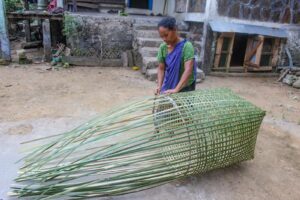
Siangkhnai Community
Nestled in the picturesque landscapes of the East Khasi Hills, Siangkhnai community thrives on a tradition as old as time itself: bamboo craft. Here, amidst the lush greenery, bamboo isn’t just a plant; it’s a way of life—a cornerstone of cultural heritage and economic sustenance.
For generations, the indigenous people of Siangkhnai have mastered the art of bamboo crafting, passing down their skills from parent to child. Bamboo, a revered member of the Poaceae family, holds a special place in their daily lives, serving as the primary material for crafting a myriad of items, from baskets to fishing traps. The community pulses with the rhythm of craftsmanship, with virtually every household engaging in some form of bamboo craft. This tradition not only preserves cultural heritage but also provides employment opportunities and a reliable source of income, ensuring the community’s resilience in the face of changing times.
Among the remarkable creations of Siangkhnai’s artisans are the “ruh nam”, a cane fish trap, and the “ruh kem sim/syiar”, a bird basket, both meticulously crafted from bamboo sticks. These functional marvels speak to the ingenuity of the community members, who have honed their craft to cater to their specific needs. From ‘khasi baskets’ for storing fruits and vegetables to “knups” serving as seasonal umbrellas during agricultural activities, each creation is a testament to the deep integration of bamboo craft into daily life. Even during scorching summers, locals find respite from the heat under the shade of bamboo cane hats known as “sat-tas”, showcasing the versatility of this remarkable plant.
As the rhythm of bamboo craft echoes through the community, it reinforces the unique identity of Siangkhnai’s community. While some community members have begun cultivating bamboo on their properties, the forest remains their primary reservoir of this invaluable resource, symbolizing their deep connection to nature and tradition. Through their craftsmanship, the people of Siangkhnai not only preserve their cultural heritage but also sustain their livelihoods, ensuring that the legacy of bamboo craft continues to thrive for generations to come.
In Siangkhnai community, bamboo isn’t just a material; it’s a bridge that connects the past with the present, tradition with innovation, and culture with livelihoods. As artisans weave intricate patterns and shapes from humble bamboo stalks, they breathe life into their heritage, crafting a future that is as vibrant and resilient as the bamboo itself.
Bamboo crafting stands as a testament to the resilience and creativity of the indigenous communities of the Khasi Hills and Ri-Bhoi. Through the NESFAS project “Protection of Forests in Meghalaya by Adopting Participatory, Gender-Centric, and Equitable Approaches,” supported by The Nature Conservancy, detailed documentation through the People’s Biodiversity Register (PBR) offered valuable insights of this timeless craft of bamboo artistry. Through centuries of tradition and craftsmanship, these artisans have transformed bamboo into works of art that not only serve practical purposes but also preserve cultural heritage and reinforce community identity. As we look ahead to the future, let us cherish and support the tradition of bamboo crafting, ensuring that this timeless art form continues to thrive for generations to come.